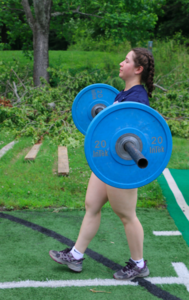When I program for my athletes I categorize my movement patterns into the following 6 main categories.
- Squatting
- Hinging
- Upper Body Pushing
- Upper Body Pulling
- Carries
- Trunk/core
Note: The weightlifting movements, deadlifts, and other complex movements are combinations of the movement categories. These six basic movement patterns can be combined to create more advanced movements.
I categorize these movement patterns so that I can make sure I am evenly working the entire body. I don’t want to create any imbalances or weak points. I want to make sure to have a balance between the squatting and hinging categories as well as the upper body pushing and pulling categories. That does not mean that I necessarily want a 1:1 ratio between all the categories. If someone has an imbalance, I may want the ratio to be 2:1 or even 3:1 to work out the imbalance. We may do less squatting and more posterior chain work to even out their leg strength. But if someone is very well balanced I do tend to stay around a 1:1 ratio.
For every set of squatting, I want to incorporate some sort of hinging to balance that out. I want to create well rounded athlete that will stay healthy. It is important to look at the training volume over the entire week. You can have one day be squat day and have another day being your hinging/posterior chain day where all the exercises performed that day are from that movement category. Or you can break it up evenly and have an equal amount of hinging and squatting exercises throughout each session of the week. It really depends on your personal preference. The most important thing is overall weekly balance.
I note this to be especially important in the upper body. For those of us who lived on the bench press growing up, we may have some limited shoulder mobility with an overdeveloped chest and a weak back. We need full shoulder range of motion! It is important to equal out your pushing and pulling of the upper body. Plus, big upper backs are way more impressive than big chests. Look at Dorian Yates and Ed Coan. If you have a big back, I know you are strong!
[thrive_leads id=’9063′]
Exercises for Squatting
Squatting involves any exercise that requires a bend in the knee and requires the body to “push” weight away from the body. The most common exercises of this category include all the variations of:
- Squats
- Lunges
- Leg press
- Plyometrics
- Step ups
Exercises for Hinging
Hinging involves any exercises that requires a bend (flexion) in the hips. Most of the time the bending (flexing) is followed by hip extension (squeezing the glutes and bringing the trunk back up to neutral). We tend to refer to these as “pulling” exercises. The most common exercises of this category include:
- RDLs
- Good mornings
- KB swings
- Back extensions
- Reverse hypers
Exercises for Upper Body Pushing
Upper body pushing can further be broken down into horizontal pushing and vertical pushing. Horizontal pushing includes:
- Bench press
- Floor press,
- Push-ups,
Vertical pushing includes:
- Strict press
- Push press
- Military press
- Dips
Exercises for Upper Body Pulling
Upper body pulling can also be broken down into horizontal pulling and vertical pulling. Horizontal pulling includes:
- Any variation of rowing
Vertical pulling includes:
- Pull-ups
- Lat pull downs
- Straight arm pull downs
Exercises for Carries
Carries are exactly what they sound like. Pick up a heavy object and move it. There is no easier way to get strong and increase your work capacity than just pick something up and move it for 30-45 seconds. Then take a rest and do it again. I really like to do these unilaterally to work out any imbalance an athlete may have.
Exercises for Trunk and Core
Trunk and Core movement patterns can be broken down into front, side, and low back exercises. Front exercises include:
- Planks
- Leg raises
- Dead bugs
- Front rack holds
Side includes:
- Side planks
- Unilateral carries can even fit here
- Side to side leg raises
Low back exercises include:
- Reverse planks
- Back extensions
- Reverse hypers
[thrive_leads id=’8207′]

